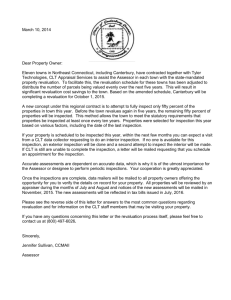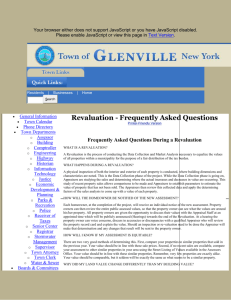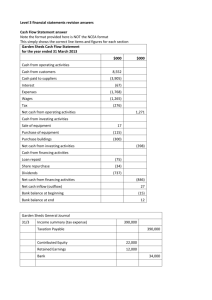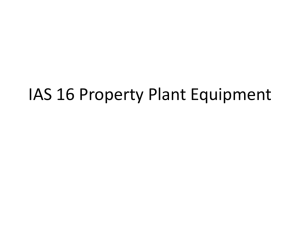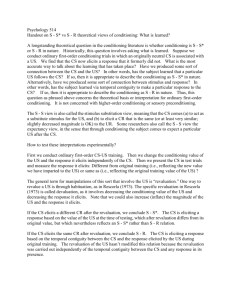Asset Revaluation or Impairment
advertisement
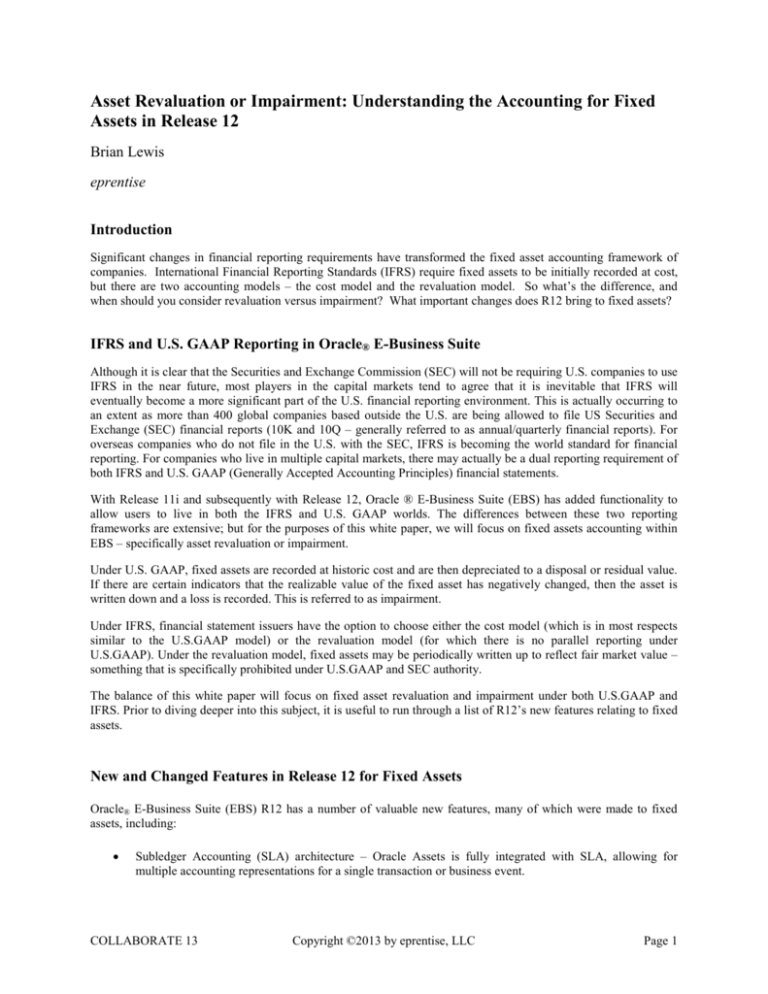
Asset Revaluation or Impairment: Understanding the Accounting for Fixed Assets in Release 12 Brian Lewis eprentise Introduction Significant changes in financial reporting requirements have transformed the fixed asset accounting framework of companies. International Financial Reporting Standards (IFRS) require fixed assets to be initially recorded at cost, but there are two accounting models – the cost model and the revaluation model. So what’s the difference, and when should you consider revaluation versus impairment? What important changes does R12 bring to fixed assets? IFRS and U.S. GAAP Reporting in Oracle® E-Business Suite Although it is clear that the Securities and Exchange Commission (SEC) will not be requiring U.S. companies to use IFRS in the near future, most players in the capital markets tend to agree that it is inevitable that IFRS will eventually become a more significant part of the U.S. financial reporting environment. This is actually occurring to an extent as more than 400 global companies based outside the U.S. are being allowed to file US Securities and Exchange (SEC) financial reports (10K and 10Q – generally referred to as annual/quarterly financial reports). For overseas companies who do not file in the U.S. with the SEC, IFRS is becoming the world standard for financial reporting. For companies who live in multiple capital markets, there may actually be a dual reporting requirement of both IFRS and U.S. GAAP (Generally Accepted Accounting Principles) financial statements. With Release 11i and subsequently with Release 12, Oracle ® E-Business Suite (EBS) has added functionality to allow users to live in both the IFRS and U.S. GAAP worlds. The differences between these two reporting frameworks are extensive; but for the purposes of this white paper, we will focus on fixed assets accounting within EBS – specifically asset revaluation or impairment. Under U.S. GAAP, fixed assets are recorded at historic cost and are then depreciated to a disposal or residual value. If there are certain indicators that the realizable value of the fixed asset has negatively changed, then the asset is written down and a loss is recorded. This is referred to as impairment. Under IFRS, financial statement issuers have the option to choose either the cost model (which is in most respects similar to the U.S.GAAP model) or the revaluation model (for which there is no parallel reporting under U.S.GAAP). Under the revaluation model, fixed assets may be periodically written up to reflect fair market value – something that is specifically prohibited under U.S.GAAP and SEC authority. The balance of this white paper will focus on fixed asset revaluation and impairment under both U.S.GAAP and IFRS. Prior to diving deeper into this subject, it is useful to run through a list of R12’s new features relating to fixed assets. New and Changed Features in Release 12 for Fixed Assets Oracle® E-Business Suite (EBS) R12 has a number of valuable new features, many of which were made to fixed assets, including: • Subledger Accounting (SLA) architecture – Oracle Assets is fully integrated with SLA, allowing for multiple accounting representations for a single transaction or business event. COLLABORATE 13 Copyright ©2013 by eprentise, LLC Page 1 • • • • • • Enhanced mass additions for legacy conversions – Use the mass additions process to convert data from a previous asset system. Automatic preparation of mass additions – Default rules and public Application Programming Interfaces (APIs) that can be used to complete the preparation of mass addition lines automatically. Flexible reporting using XML Publisher – Thirteen customizable new asset reports. Automatic depreciation rollback – Rollback can be executed on select assets as required vs. the entire asset book, and it is no longer required to be run manually. Enhanced functionality for the energy industry. Retirements and revaluations are now allowed in the period of addition. The many benefits of these additions include process efficiencies, flexible accounting and reporting and industry enhancements. From an acquisition or divestiture perspective, legacy system conversions from disparate standards such as U.S. GAAP and IFRS are specifically addressed. So how are U.S. GAAP and IFRS the same and where do they differ when addressing fixed assets? Comparing IFRS and U.S. GAAP for Business Combinations/Fixed Asset Accounting The table below summarizes and compares U.S. GAAP and IFRS requirements for fixed assets after an acquisition. U.S. GAAP IFRS Depreciation Same Same Revaluation Prohibited Allowed/Create Revaluation Surplus Depreciation after Revaluation N/A Allowed Impairment Direct Write Down Write Down to Revaluation Surplus First, then Direct Write Down U.S. GAAP is a conservative rule-based accounting standard that focuses on P & L (profit and loss) financials for use of owners of the entity (shareholders), while IFRS is more of a principle-based accounting standard that focuses on the balance sheet primarily for creditors of the entity. The significant differences in fixed assets between U.S. GAAP and IFRS are in the areas of revaluation, revaluation surplus and impairment as previously noted, all of which are defined below: Revaluation of Fixed Assets – Revaluation of a company's assets takes into account inflation or changes in fair value since the assets were purchased or acquired. There must be persuasive evidence to revalue. The change in value is credited to the revaluation surplus (reserve) account. A downward revaluation is considered impairment. Revaluation Surplus (Reserve) - The increase in value of fixed assets due to the revaluation of the fixed assets is credited to revaluation surplus (reserve). Impairment of Fixed Assets – Impairment of a fixed asset occurs when the realizable value of an asset, as shown in the balance sheet, exceeds its actual value (fair value) to the company. When impairment occurs, the business must decrease its value in the balance sheet and recognize a loss in the income statement. COLLABORATE 13 Copyright ©2013 by eprentise, LLC Page 2 Cost Model vs. Revaluation Model for Fixed Assets Cost Model In the cost model, the fixed assets are carried at their historical cost less accumulated depreciation and accumulated impairment losses. There is no revaluation or upward adjustment to value due to changing circumstances. This is similar to the model currently in use by U.S. GAAP. Example Acme Ltd. purchased a building worth $200,000 on January 1, 2008. It records the building using the following journal entry: Building 200,000 Cash 200,000 The building has a useful life of 20 years, and in this example the company uses straight line depreciation. Yearly depreciation is $200,000/20 years, or $10,000. Accumulated depreciation as of December 31, 2010, is $10,000*3 or $30,000, and the carrying amount is $200,000 minus $30,000, which equals $170,000. We see that the building remains at its historical cost and is periodically depreciated with no other upward adjustment to value. If an asset is subsequently valued down due to impairment, the loss is charged to the income statement as impairment loss. Revaluation Model In the revaluation model, an asset is initially recorded at cost, but subsequently its carrying amount may be increased to account for appreciation in value. The difference between the cost model and revaluation model is that the revaluation model allows both downward and upward adjustment in value of an asset, while the cost model allows only downward adjustment due to impairment loss. This is the model currently adopted by IFRS. Example Consider the example of Acme Ltd. used in the cost model. Assume that on December 31, 2010, the company intends to switch to a revaluation model and carries out a revaluation exercise which estimates the fair value of the building to be $190,000 (again, at December 31, 2010). The carrying amount at the date is $170,000 and revalued amount is $190,000, so an upward adjustment of $20,000 is required for the building account. It is recorded through the following journal entry: Building 20,000 Revaluation Surplus 20,000 Revaluation Surplus Upward revaluation is not considered a normal gain and is not recorded on the income statement; rather it is directly credited to an equity account called revaluation surplus. Revaluation surplus holds all the upward revaluations of a company's assets until those assets are disposed. COLLABORATE 13 Copyright ©2013 by eprentise, LLC Page 3 Depreciation after Revaluation The depreciation in periods after revaluation is based on the revalued amount. In the case of Acme Ltd., depreciation for 2011 was the new carrying amount divided by the remaining useful life, or $190,000/17 which equals $11,176. Reversal of Revaluation If a revalued asset is subsequently valued down due to impairment, the loss is first written off against any balance available in the revaluation surplus. If the loss exceeds the revaluation surplus balance of the same asset the difference is charged to the income statement as impairment loss. Example Suppose on December 31, 2012, Acme Ltd. revalues the building again to find out that the fair value should be $160,000. The carrying amount as of December 31, 2012, is $190,000 minus two years depreciation of $22,352 which amounts to $167,648. The carrying amount exceeds the fair value by $7,648, so the account balance should be reduced by that amount. We already have a balance of $20,000 in the revaluation surplus account related to the same building, so no impairment loss will go to the income statement. The journal entry would be: Revaluation Surplus 7,648 Building Account 7,648 Had the fair value been $140,000, the excess of the carrying amount over fair value would have been $27,648. In that situation, the following journal entry would have been required: Revaluation Surplus 20,000 Impairment Losses 7,648 Building 20,000 Accumulated Impairment Losses Gain in Value of Building 7,648 300,000 Revaluation Surplus 20,000 EBS Considerations for the Revaluation Model In EBS, you can revalue all categories in a fixed asset book, all assets in a category, or just individual assets. Revaluing all categories in a book or all assets in a category is considered “Mass Revaluation” – that is, you can revalue assets en masse. Revaluing individual assets is effected on an asset-by-asset basis. COLLABORATE 13 Copyright ©2013 by eprentise, LLC Page 4 Regardless of the method used, a prerequisite to performing an asset revaluation is setting up your revaluation rules and accounts, which is done when you define your depreciation books. If you choose to allow revaluations, you must specify your revaluation rules – specifically, whether you will allow EBS to “[r]evalue accumulated depreciation. If you do not revalue accumulated depreciation, Oracle Assets transfers the accumulated depreciation to the revaluation reserve account.” i The Mass Revaluation process includes the following steps: • • • • Create Mass Revaluation Definition Preview Revaluation Run Revaluation Optionally Review Revaluation COLLABORATE 13 Copyright ©2013 by eprentise, LLC Page 5 To revalue all assets in a category: • • • • • • • • • • • • Navigate to the Mass Revaluations window Enter the Book for which you want to revalue assets Enter a Description for the revaluation definition (IMPORTANT: Note the Mass Transaction Number) Specify revaluation rule. Enter the category you want to revalue Enter the revaluation percentage rate to revalue your assets. Enter either a positive or negative number. Override default revaluation rules if necessary. Choose Preview (Note: You must preview before EBS will let you proceed) If, after previewing, you need to make changes, edit the revaluation rule or percentage. Find the revaluation definition using the Mass Transaction Number. Choose Run. Oracle Assets begins a concurrent process to perform the revaluation. Review the log file after the request completes. To revalue an individual asset: • Enter the asset number you wish to revalue instead of a category. Revaluation Functionality is Not for Fixed Asset Revaluation Under Purchase Accounting Rules One area of confusion that we have encountered several times is whether the asset revaluation functionality of Oracle EBS can be used to revalue assets of an acquired company. Under Financial Accounting Standard 141(R) and IFRS 3, Business Combinations, companies are required to revalue their assets to fair value at date of acquisition. This is mandatory for all companies that have to file annual reports with the SEC or roll-up into an SEC reporting company. For our purposes, this means just about everyone. The same applies to IFRS reporting companies. It used to be that companies could use pooling of interest where they could just leave the fixed assets from the acquired company’s books as-is for cost, accumulated depreciation, and date in-service. This is no longer allowable. Since under both U.S. GAAP and IFRS there is no such thing as a "merger," there will always be a company identified as the acquired. For this company, all fixed assets need to (1) be restated to fair value at date of acquisition; (2) have the date in service restated to date of acquisition; and (3) have any accumulated depreciation zeroed out. If a company can support a contention that netting accumulated depreciation with cost is materially the same as fair value, the acquired company may do that, but the net value has to be migrated to the original cost field, the accumulated depreciation zeroed, and the date in-service still reset to date of acquisition. If the company is restating to fair value and cannot use the netting method, then a number of new fair values must be done for each of the fixed assets. Oracle Mass Revaluation (OMR) functionality will not work for these types of revaluations for the following reasons: 1. 2. 3. The date placed in-service must be changed to date of the business combination – OMR does not support this. OMR mass and category revaluation will not accommodate netting accumulated depreciation or loading multiple, non-percentage driven fair value restatements. Individual asset revaluation is impractical for large numbers of assets and also does not accommodate netting accumulated depreciation or resetting the date placed in service. For asset revaluations needed as a result of a business combination, using OMR is not a viable option. COLLABORATE 13 Copyright ©2013 by eprentise, LLC Page 6 Conclusion Addressing fixed assets in both the U.S. GAAP and IFRS accounting models has become easier in R12. The flexibility of the accounting rule setup allows requirements in different legislative, geographic or industry contexts within a single instance. The mass additions and automatic preparation processes can be used to convert data from legacy systems following an acquisition or consolidation. And, reporting is flexible with prepopulated or customizable templates. Use the cost model with accumulated depreciation and accumulated impairment losses for U.S. GAAP requirements. While IFRS has the flexibility to use either of the accounting models discussed in this white paper, the revaluation model is most commonly used. Although the FASB (Financial Accounting Standards Board) and IASB (International Accounting Standards Board) have made significant progress toward convergence of these models through joint projects, much work remains. Until or if convergence is achieved – estimated to be in 2015, according to the latest reports – both accounting models for fixed assets need to be considered during a business combination. End Notes: i Oracle Library – Revaluing Assets (http://docs.oracle.com/cd/A60725_05/html/comnls/us/fa/revaling.htm) COLLABORATE 13 Copyright ©2013 by eprentise, LLC Page 7

